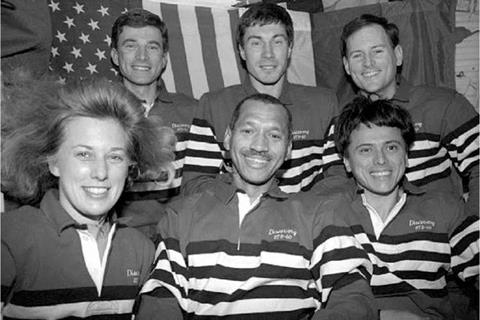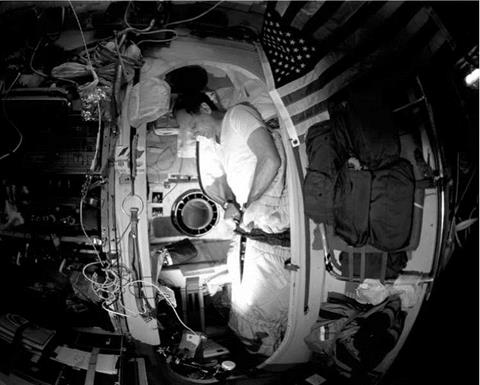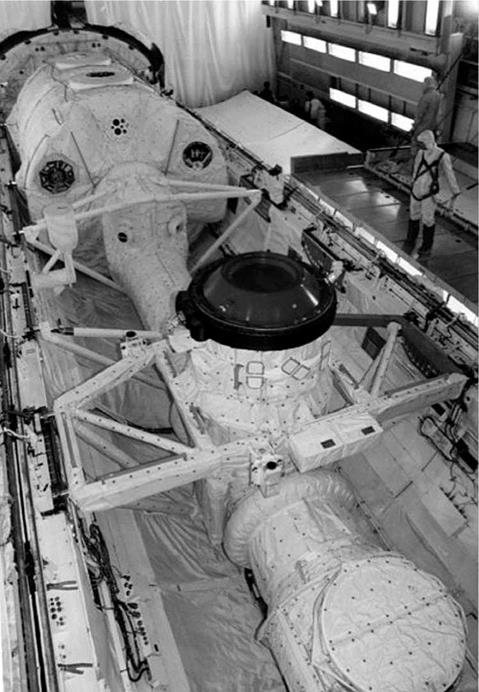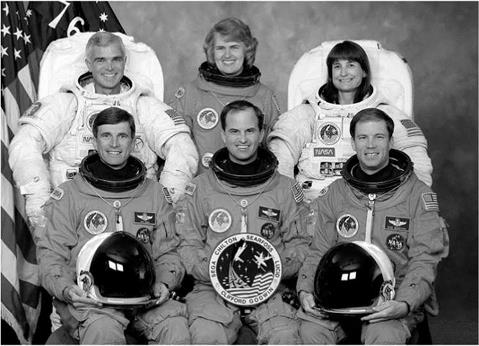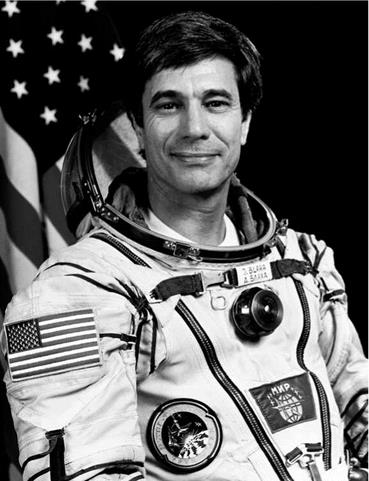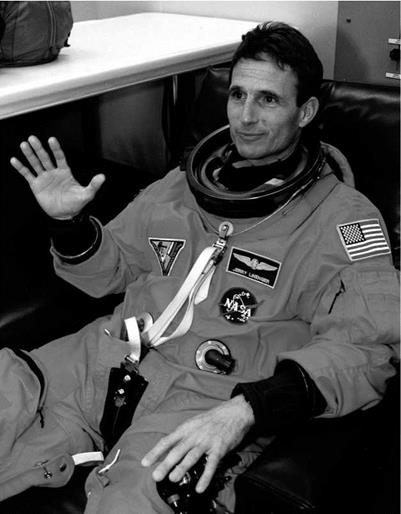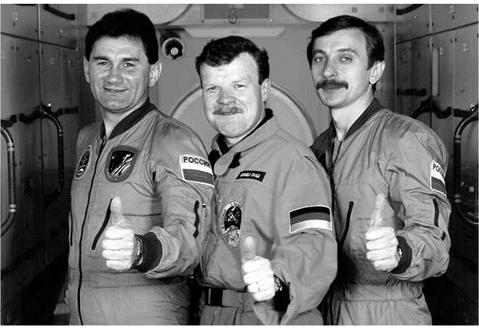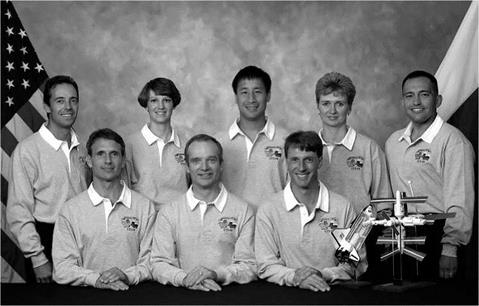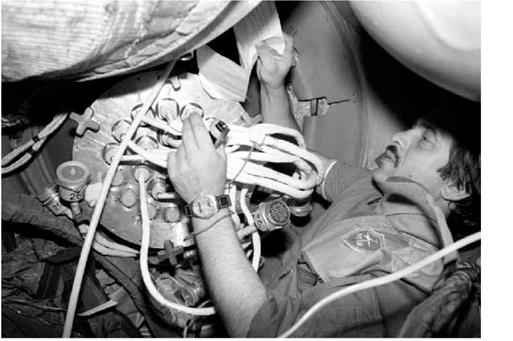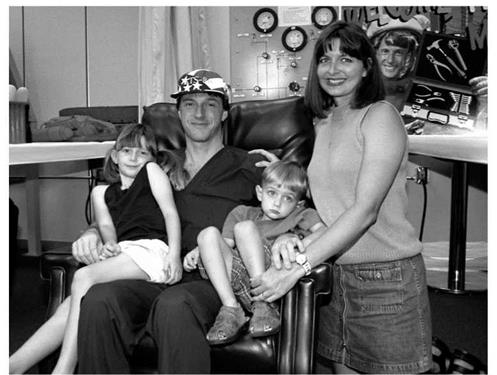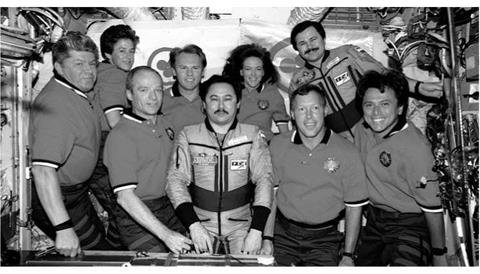Shuttle-Міг: Real co-operation
The Shuttle-Міг program was born in July 1991 when President George Bush and Mikhail Gorbachev signed an agreement for a Soviet cosmonaut to fly aboard the space shuttle, and a U. S. astronaut to fly a Soyuz-TM mission. The two great powers had wanted to build on the Apollo-Soyuz mission of 1975 for some time; there had been suggestions that a Soyuz would visit Skylab, but that was deemed unpractical because of the differences in the docking interface between the two craft. There had also even been a suggestion in 1984 that the shuttle dock with Salyut 7 in a sort of simulated space rescue, but nothing ever came of the idea.
This agreement was expanded upon in October 1992 to include a shuttle mission to the Mir space station, and a long-duration stay by a U. S. astronaut on Mir. The mission to Mir by the shuttle was made possible by the availability of the docking adapter that originally had been built for the Soviet shuttle, Buran. That adapter would now be fitted to the shuttle Atlantis. For the first time in its history the shuttle had somewhere to go, although the shuttle’s original designers surely had no idea that its first such mission would be to a product of the Soviet Union!
In 1993 it was decided that the shuttle would in fact dock with Mir ten times, exchanging crews and allowing U. S. astronauts several long-duration missions. It was additionally agreed that more than one Russian would fly on the shuttle. By this time, of course, Russia was a partner in the newly redesigned International Space Station (ISS), and so the new program was divided into three phases. Phase 1 would see the ten Mir-Shuttle dockings, involving at least five long-duration flights by NASA astronauts on board the Russian station for which NASA would pay a fee. There would also be at least two flights by Russians on board the shuttle. Phase 2 would signal the beginning of construction of the ISS with launches from the U. S. and Russia of station elements, that would lead to a permanent three-man crew. Phase 3 would complete construction with the elements from other partner nations such as Japan and the ESA.
|
STS-60 inflight crew portrait |
Sergei Krikalev was chosen along with Vladimir Titov as the first Russians to train for a flight on the shuttle as mission specialists. Krikalev became the prime candidate, and he flew on STS-60 in February 1994. This mission had nothing to do with space station operations, but it allowed Krikalev to discover how Americans flew in space, and that flying on the shuttle was very different to flying a Soyuz to the Mir station. This mission lasted a mere eight days; a short sprint in comparison with the months he had spent on board Mir. Activities were far more intense and scripted than his time on Mir, and it proved that the NASA mission planners would have to change their strategy considerably when it came to mounting both the long-term Mir missions and future mission to the ISS.
To underline this message, Vladimir Titov flew on board the shuttle Discovery on mission STS-63 in February 1995. This was not a docking mission, but it was planned to rendezvous with Mir as an engineering demonstration. Although the mission did suffer from some unfortunate malfunctions including one that postponed the flight and another, a thruster leakage, which nearly cancelled the close approach to the Mir station, valuable data for the future docking missions was obtained.
The next part of Phase 1 to be fulfilled was the first long-duration flight by a NASA astronaut to the Mir space station. Additionally this astronaut, Norman Thagard, would be the first to be launched aboard a Soyuz-TM spacecraft. Thagard was an experienced flyer with four shuttle flights under his belt, but he and NASA quickly discovered what Krikalev and Titov had on their shuttle missions, which was
|
Thagard in his sleep restraint on Mir |
that a space shuttle mission and a long-duration flight on a space station are two very different things. The Mir mission required much more flexibility, both from the crewmember and from those on the ground, but NASA seemed to have forgotten the lessons learnt twenty years previously with Skylab. Thagard was dismayed to discover that his ground controllers were programming every minute of his day from waking in the morning to going to bed at night. Much the same frustrations that had plagued the Skylab 4 crew now manifested themselves in Thagard. The problem was exacerbated by the cultural differences for Thagard; he was completely cut off from his compatriots, and often went for days without speaking any English or speaking to his friends and colleagues.
The historic docking of the space shuttle Atlantis with the Mir space station echoed that of the Apollo-Soyuz mission in 1975. Atlantis launched on 27 June 1995 and docked with Mir two days later. The crew consisted of five U. S. astronauts, and the new Mir 19 crew of Anatoli Solovyov and Nikolai Budarin, so that Mir now had a combined crew of 10, the largest in history, beating the previous record of 8 on shuttle mission STS-61A, which flew the first German Spacelab mission. Atlantis also had a Spacelab module in its payload bay to take advantage of the opportunity to study the physiology of the three existing Mir crewmates whilst still in space. Atlantis had brought plenty of supplies to Mir, far more than the Progress freighters could carry, and better, it allowed many things to be returned to Earth from Mir, something that could only be done in small quantities in the Soyuz spacecraft. It allowed the Russians to return faulty equipment to allow diagnostics by Russian engineers; it also allowed experiment results to be returned quickly. Perhaps the most important item delivered by the shuttle was water. Mir was able to recycle about 60% of its own water, but most of that was not fit for drinking. Atlantis was able to deliver half a tonne of water from its fuel cells, where water is a natural by-product and would normally be dumped overboard. It was during all of this back and forth from Mir to Shuttle that it was realized that the ISS would need very careful stock control in order to determine what was on board the station, where it was, and its current status. Mir had not benefited from this kind of control and consequently many items that were unknown, or at least forgotten, were crammed into every available space, often behind wall panels.
Bonnie Dunbar had originally been due to be left behind by Atlantis for a long – duration mission of her own, but this plan had to be abandoned to allow the European Space Agency (ESA) to carry out a long-duration mission by Thomas Reiter of Germany. At this point in time, with the ISS construction running late, many nations wished to fly experiments and people on Mir to gain experience. This meant that finding space on Mir’s increasingly busy schedule was difficult. Reiter joined the Mir crew on Soyuz-TM 22 in September 1995, and expected to stay on board for 135 days, although his mission was eventually lengthened by a further 42 days. His presence on the station meant that NASA could not carry out a long- duration mission of their own at the same time, as that would mean there were four permanent residents on the station, and the Soyuz lifeboat only carries three.
Therefore when Atlantis undocked on the 4 July, Dunbar was still on board along with the Mir 18 crew, including Norm Thagard. The old Mir crew rode back to Earth in new prone seats on the mid-deck. This basically involved the crew lying on their backs on the mid-deck floor with their feet in the storage lockers in front of them; it was felt that this was a better way for the long-duration crews to return to Earth. Nevertheless, Thagard broke the medical rules for his flight by walking out of the shuttle to the waiting astrovan.
Atlantis’ mission to Mir had been made possible, as mentioned previously, by the Russian docking adapter. However, the corresponding adapter on the Mir was attached to the end of the Kristall module. In order for the shuttle to dock there without coming too close to the solar arrays, Kristall had to be moved from its normal position—on the docking node at right angles to the Mir base block—to the end of the Mir base block’s docking node. In order to get around this necessity for future missions the next shuttle would bring an extended docking port which would be attached to the end of Kristall in its normal position. So it was that the shuttle Atlantis flying mission STS-74 arrived at the station in November 1995 with the new docking module in its payload bay. Two extra solar panels for Mir were transported affixed to the sides of the docking module, and were to be fitted to Mir at a later date by the resident crew. The Atlantis crew delivered many items to Mir, again far more
|
Shuttle docking adapter installed in Atlantis |
than could be achieved by a Progress, and in fact more than the previous Atlantis mission, due to not having to carry Spacelab into orbit. The cargo consisted of food, water, replacement lithium hydroxide canisters, many items for future NASA research, plus many personal items for the Mir crew including a guitar that was put to good use by Canada’s Chris Hadfield in a song describing Miss Dolly Parton!
NASA now had the opportunity to fly a further six astronauts on long-duration flights aboard the Mir station. Perhaps surprisingly there was not a great rush of volunteers to fill these positions, and NASA struggled to find 12 astronauts (including back-ups) who were willing to undergo the training in Russia for a year or more, and that fulfilled the criteria that the Russians had laid down for Mir crewmembers. The initial schedule for NASA’s missions to Mir or increments as they liked to call them looked like this.
|
NASA increment |
Prime |
Back-up |
Duration |
|
2 |
Shannon Lucid |
John Blaha |
5 months |
|
3 |
Jerry Linenger |
Scott Parazynski |
4 months |
|
4 |
John Blaha |
Wendy Lawrence |
6 months |
|
5 |
Scott Parazynski |
Wendy Lawrence |
4 months |
Norm Thagard had two different back-ups during his training cycle for the first NASA increment—Bill Readdy and Bonnie Dunbar. Bill Readdy was apparently persuaded to be Thagard’s non-flying back-up on the understanding that he would fly a later mission to Mir in which he would be launched by shuttle, but return to Earth in a Soyuz, something that no NASA astronaut had done up to that point. Ultimately Readdy was convinced to take up the position of Director of Operations (DOR) at Star City and later he commanded the mission that retrieved Shannon Lucid from Mir and delivered John Blaha.
Scott Parazynski was the first astronaut to fall foul of the Russian system. He had been training as back-up to John Blaha for the third U. S. increment aboard Mir when it was found that he was fractionally too tall for the existing Soyuz capsule. A new design of Soyuz was in the pipeline that would allow crewmembers of his stature, but this would not arrive soon enough, and he was removed from the program. Wendy Lawrence was doubly unlucky. She was initially removed from the program because she was too short for the Soyuz. And although she was reinstated in the program to succeed Michael Foale on the sixth increment to Mir, it was decided after the catastrophic events during Foale’s flight that a crewmember capable of carrying out an EVA was required, and she proved to be too short to wear a Russian Orlan spacesuit, plus she had never been EVA trained at NASA, so she was removed from the crew rotation again to be replaced by David Wolf. This meant an accelerated training program for Wolf, as he had never served as a back-up crewmember, but he made the best of the situation and crammed his training in before launch. James Voss came into the breach as non-flying back-up for two of the increments, but he had already been assigned to an early ISS crew, and would make good use of his Mir training experience. After these changes the flight schedule now looked like this.
|
NASA increment |
Prime |
Back-up |
Duration/EVA |
|
2 |
Shannon Lucid |
John Blaha |
6 months |
|
3 |
John Blaha |
Jerry Linenger |
4 months |
|
4 |
Jerry Linenger |
Michael Foale |
4l months + EVA |
|
5 |
Michael Foale |
James Voss |
5 months + EVA |
|
6 |
David Wolf |
Andy Thomas |
4 months + EVA |
|
7 |
Andy Thomas |
James Voss |
41 months |
The remaining seven shuttle missions to Mir all followed the same pattern. The shuttle would bring the next replacement NASA crewmember and/or return with the old one. The shuttle would be fitted with a SpaceHab module in its payload bay to transport more supplies than previous shuttle flights to Mir, including experiments, food, clothing, water, and bring back experiment results and obsolete equipment, thus alleviating Mir’s clutter problem slightly.
Shannon Lucid was the next willing volunteer for a long-duration mission to Mir. She was delivered aboard the shuttle Atlantis on mission STS-76 arriving on 24 March
|
STS-76 crew portrait, Lucid middle back row |
1996, and was scheduled to stay aboard until Atlantis returned to collect her in early August.
A veteran of four previous shuttle missions, Lucid had eagerly volunteered for her mission to Mir, and undertaken the training in Russia with great zeal, seeing the chance to live on board a Russian space station with two Russians as a unique opportunity. Just over a month into her mission the final module, Priroda, to be added to the Mir complex, arrived. The contents of Priroda had been provided by many nations including Russia, America, Germany, France, and Canada, and truly reflected Mir’s increasing role as a melting pot of international collaboration. Lucid’s time on board Mir seemed to run more smoothly than had Thagard’s before her. She was free to work at her own pace as she worked her way through the four-day task list that was updated by her NASA colleagues on the ground every day, she was also able to send and receive e-mails from friends and colleagues which helped to ward off any feelings of isolation. In mid-July Shannon was told that her mission would have to be extended to mid-September due to problems with the solid rocket boosters (SRBs) that had been stacked for Atlantis’ mission to retrieve her (STS-79). A previous shuttle mission, STS-78, had experienced a problem with erosion of the field joints in its SRBs, which was a problem not dissimilar to that suffered by Challenger during its fateful flight in January 1986. It was thought that this erosion had been caused by a change in the type of adhesive used during assembly of the SRBs, and the boosters for STS-79 had been assembled in the same way. It was therefore decided to replace those boosters with the ones that had been set aside for STS-80, which used the original type of adhesive.
When the crew of STS-79 did dock with Mir on 19 September, Shannon had already broken two space records. On 7 September she had broken Elena Kondakova’s female duration record of 169 days, and on 17 September she broke the visitors (i. e. non-Russian) record of 179 days, which had recently been set by Thomas Reiter. The change of crew between Lucid and new arrival, John Blaha, was done in much the same way as the Russian crewmembers. They exchanged the seat liners for the Soyuz lifeboat capsule, and Lucid briefed Blaha as to the status and location of her many experiments and offered tips on living aboard the station. When Atlantis landed at the Kennedy Space Center Lucid had also set a new American duration record of 188 days. She adapted to Earth gravity more rapidly than expected, walking off the shuttle to the crew transport vehicle before later meeting with President Clinton.
Within NASA and the Phase 1 program there seemed to be two distinct camps of opinion on the collaboration with the Russians. Some felt that it was a business deal, pure and simple: NASA paid the Russians, plus offered the occasional seat on the shuttle, and in return the Russians provided training and room and board on the Mir station. Others believed that it was a proper partnership, or that at least it ought to be. With proper give-and-take on both sides, decisions being made jointly, and perhaps most importantly lessons learned on both sides, including language and working skills, organization of long-duration flights, and technology transfer between the two nations. This segregation within the program seemed to extend to the astronauts in training for the upcoming missions to Mir. Shannon Lucid for example, was definitely a member of the latter group; she saw the whole joint program as a massive opportunity, both for NASA and for her personally. She threw herself into her training, taking care to learn the Russian language and customs, and making sure that she integrated well with her assigned crew. This attitude served her well when time came to fly her mission, especially when it was extended. It was less clear which group John Blaha fell into; he was the only pilot-astronaut assigned to a Mir mission, and his background in the U. S. Air Force could certainly have given him reason to harbour a certain amount of distrust towards his Russian colleagues. Certainly his attitude cannot have been helped when the crew that he been training with—commander Gennadi Manakov and flight engineer Pavel Vinogradov—were removed from the flight just one month before his launch to Mir owing to a problem with Manakov’s EKG. The pair were grounded and replaced with their back-ups, commander Valery Korzun and flight engineer Aleksandr Kaleri. Blaha did not even know who Kaleri was, but the insertion of Korzun worried him. He had carried out his winter survival training with Korzun and Michael Foale, and found the man to be condescending in the extreme; he could not imagine what spending four months under his command would be like. Blaha’s troubles had not started there; for months he had struggled with the lack of support from the Phase 1 office at NASA. He had also become embroiled in an argument with both sides about carrying his own personal set of notes to Mir. His lack of expertise with the Russian language only added fuel to the fire, and all in all his training cycle had been a very difficult one. When launch day finally arrived for Blaha and the crew of STS-79, he was already exhausted.
Unfortunately, things did not get any better when he arrived at the station. Korzun and Kaleri welcomed him warmly, which made him feel a little better, but when he tried his first science experiments, with the shuttle still docked at the station, he immediately hit problems. As many astronauts and cosmonauts before him had discovered, it takes a lot longer to do even the simplest things in space, than it does on the ground; despite what it might say in the checklist. His first experiment was supposed to take only 1^ hours to complete, start to finish; it ended up taking him 5 hours just to find all of the components in the sprawling cluttered station and put them together. In short, the reality was nothing like the organized straightforward training on the ground; things were not where they were supposed to be, and even if they were, there was no guarantee that they would be in working order. For a goal driven achiever, this was simply unacceptable, and the ground could not, and it seemed to Blaha, would not, help him. The ground support team acted as if Blaha was flying a shuttle mission, where everything is carefully cataloged and in its proper place; they did not seem to understand how it could be possible to not find something in a closed vehicle. Because of this lack of understanding, Blaha began to work longer and longer hours in his efforts to catch up with the timeline, which remained rigid and unaltered despite his pleas for it to be relaxed. Now, this may all sound very familiar in the light of the problems faced by the third crew aboard Skylab (they are in fact exactly the same problems) but nearly 30 years down the line, and on board a Russian station instead of an American one, with the additional issue of the language barrier only making the situation worse. It seems amazing to consider that NASA appeared
|
John Blaha portrait |
to have learnt nothing, but it seems no-one from the Phase 1 program had paid any attention to the lessons of Skylab, and worse still, even when Phase 1 did learn from its mistakes, the newly learned lessons were not passed on, or not listened to, by the Phase 2 people.
Blaha soldiered on for the remainder of his four-month stay, and found, just as the Skylab 3 crew did, that things did improve over time. He became more adept at finding things on the cluttered Mir station, and the ground controllers eventually learned to relax their grip on the flight plan and leave some of the planning to Blaha himself. Nevertheless, he was quite relieved to hand over the reins to his replacement Jerry Linenger, who arrived aboard the space shuttle Atlantis on mission STS-81. Linenger was different from the previous Mir residents from NASA in that he had
|
Linenger before launch |
only flown one shuttle mission, and he had been assigned hastily to comply with the Russian requirement that all astronauts for Mir be flight experienced. The plans for his increment were slightly different too; he was to carry out an EVA, the first by an American in a Russian Orlan spacesuit, and he was to spend the longest time on the station at that time. His attitude towards his Russian hosts was noticeably different from his predecessors too. He seemed to feel that NASA was paying the Russian Space Agency for a service, one that they were only barely providing. He seemed to have little interest in integrating himself into his two different Mir flight crews he would serve with. His main priority was to carry out his mission, and everything else
|
Soyuz-TM 25 crew, Tsibliyev, Ewald, and Lazutkin |
was secondary (at least) to that goal. This attitude seemed likely to put him on a collision course with his Russian crewmates, and so it proved to be.
The Mir resident crew when Linenger arrived were still Valeri Korzun and Aleksandr Kaleri, and they welcomed Linenger just as warmly as they had John Blaha. As Linenger settled down to life on Mir, and began his schedule of experiments, Korzun and Kaleri noticed that he kept to himself and did not often join them for meals or other “social” occasions, but they let him be as the end of their increment slowly approached. In March 1997, a Soyuz arrived with the replacement Mir crew; it also carried a cosmonaut researcher, Reinhold Ewald from Germany, who would stay on board the station during the handover period.
Mir became a little crowded and cosy with six men on board, especially at meal times when all six would float around the table in the base block. The extra three-man crew on Mir required that the oxygen supply be supplemented by use of solid fuel oxygen generators (SFOG) into which tanks containing a chemical which produced oxygen when it was heated were inserted. These tanks were commonly referred to as “candles” by the cosmonauts. One evening as most of the crew gathered in the base block for the final meal of the day, Sasha Lazutkin, one of the new arrivals broke from the meal and went into the Kvant module to carry out the final candle burn of the day. Almost immediately he realized something had gone wrong. The candle started its burn in the normal way, but then he heard the tank hiss and, almost unbelievably, it burst into flames. Lazutkin was momentarily frozen by the sight before him, and even when he tried to shout a warning he was not heard. It was Ewald who saw the fire and screamed “Fire” in Russian. The rest of the crew finally realized what was happening, and Korzun dived into the Kvant module with Lazutkin. However, they quickly realized that it was not going to be easy to put out a fire in weightlessness that was being fed by the chemical reaction taking place in the candle. Fire extinguishers proved to be almost useless, and the fire continued to burn despite the efforts of the crew until slowly the solid fuel was consumed. By this time, the base block was almost filled with smoke, and the crew all donned oxygen masks; except Jerry Linenger, who was not in the base block. The fire alarm finally went off alerting Linenger in Spektr, he rushed into the node between Spektr and the base block and tried to find an oxygen mask for himself, the first mask he tried failed to work, the second was more successful. It was realized later that several of the emergency oxygen masks tried by all members of the crew were faulty. In addition, the first fire extinguisher that Linenger tried in Priroda was securely fastened to the wall and would not come off. The new commander, Vasily Tsibliyev, also tried to take an extinguisher from Priroda, but it too was securely fastened to the wall. It turned out that the transport straps put in place for Priroda’s launch were never removed once the module reached orbit over a year and half previously. Emergency evacuation procedures called for the crew to prepare the two docked Soyuz spacecraft for departure, but one of the ships was on the other side of the fire, docked at the end of Kvant; this was the ship reserved for Korzun, Kaleri, and Ewald. Clearly, there was no way for anyone to reach it until the fire was put out. By the time the fire was finally out, most of the modules of Mir were filled with dense smoke and steam, and as thoughts turned to the effects of smoke inhalation Jerry Linenger reverted to his profession as a medical doctor. Of primary concern were the chemicals that made up the contents of the candle, and the residue of those chemicals in the smoky air. When the oxygen masks ran out, the crew donned surgical masks in an attempt to filter out any contaminants. The smoke slowly cleared, and the crew did the best they could to clean up the interior of the station, after which they washed and changed into clean clothes. Linenger carried out a health check on all of the crew checking their lungs for the effects of smoke, none of them appeared affected. After reporting the fire to the ground, the crew attempted to get some sleep.
Frank Culbertson was in the middle of a deep sleep when he was woken by his telephone. The call was to tell him about the fire, but it was not a Russian voice on the other end of the line, it was the voice of one of his support crew working at the Russian control center. Nobody from the Russian space program had thought to notify the head of the U. S. side of Shuttle-Mir that 12 hours ago one of their astronauts had just lived through the worst fire in spaceflight history.
Safety in space has always been the primary concern of NASA and the Russian space program. Both agencies had faced emergencies during their years of manned space flight, and sadly, both had suffered fatalities. The central tenet of the agreement between the two agencies was that each was responsible for the safety of the others’ astronaut or cosmonaut crews. Missions on the shuttle and on Mir had taken place so far without incident, but the fire on Mir changed the perception of safety, especially in the minds of NASA, and the U. S. politicians and public. Suddenly, the perception was that Mir was risky and unsafe, and the Russian controllers were maverick and uncaring risk-takers. It did not help that many of NASA’s own engineers felt that there was nothing to be learned from the Russians that they did not already know. Bearing in mind that Phase 1 was supposed to be the beginning of a long-standing partnership with the Russians, and that many of the lessons learnt here should bear fruit during the construction of the ISS, NASA took virtually no notice of anything the Russians did until something went wrong. Nothing exemplified the difference between the NASA and Russian way of doing things more than the attitude toward the fire. The Russians really thought that it was no big deal; they had fires on previous space stations, and there had been no problem putting them out and carrying on as normal. NASA, in contrast, spent large sums of money ensuring that every precaution against fire was taken; wiring, spacesuits, and non-flammable clothing were all checked and double-checked before flights. NASA’s attitude was perhaps understandable given the fate of the crew of Apollo 1, who died in their spacecraft on the ground, but the Russians too had lost a cosmonaut in a fire on the ground and they did not believe such precautions to be necessary. The official Russian press release only intensified the distrust between the two parties; it stated that a “microfire”, more likely described as a “small fire’’, occurred on the station for no more that 90 seconds, and that the crew easily extinguished it. Later, when both crews were back on the ground, this would be a major point of contention, Linenger was certain it had lasted about 14 minutes; other members of the crew thought it might have been about 5 minutes, perhaps more. Certainly none of them agreed that it was only one and a half minutes. As the days passed, the reactions to the fire began to calm down, but the seeds of discontent had been sown, both on the ground and on the space station Mir. The crew on board Mir, however, had plenty to occupy them. The resident crew, Tsibliyev and Lazutkin, were preparing a test in which they were to manually dock a Progress freighter. In itself, this was not an unusual occurrence; many crews had used the ability to manually dock Soyuz spacecraft and on occasion had used a remote control system to dock Progress ships from short distances when problems had surfaced with the automatic docking system. In this case, however, the crew was to attempt to dock the Progress from a range of about 8 km from the station. Tsibliyev would sit at the TORU controls that had been assembled in the base block, where he would maneuvre the Progress using two control sticks, one controlling its orientation, and the other imparting thrust fore and aft, left, and right. In front of him was a small screen, which transmited a view from the front of the oncoming Progress along with some simple radar information—that was all Tsibliyev had to judge the approach of the 7-tonne spacecraft as it hurtled toward the space station. Why, you might ask, carry out such a test? What contingency does it prepare the crew and station for? The answer has nothing to do with emergency scenarios or improving station operations, it has everything to do with money, a resource that the Russian space agency was desperately short of. The automatic docking system that was on board all Soyuz and Progress spacecraft, and the Mir space station was called Kurs, and it was manufactured in the Ukraine. Whilst the Soviet Union existed this was of no concern. But, since the break-up, and the independence of the Ukraine, it was now of utmost concern. The Ukrainian’s charge a large amount of money for this equipment, and it occurred to the Russians that maybe they could manage without it; after all, each Progress spacecraft never returned to Earth, it burned up in the atmosphere taking its expensive Kurs apparatus with it. Already the Soyuz were using Kurs that had flown and returned many times before, but the same could not be true for Progress. If they could find a way to allow the resident station crew to perform the rendezvous and docking manually it would mean they no longer needed to install Kurs in every spacecraft. The test started badly. Tsibliyev could see nothing on the monitor in front of him. He urged Linenger and Lazutkin to look out of every window to try and find the approaching Progress, but they could not see it. Finally, Lazutkin spotted the spacecraft as it emerged from behind the station’s solar arrays; it was close enough for Lazutkin to see the details of the craft’s antennas and arrays. The monitor in front of Tsibliyev finally came on and showed that Progress would miss the station by barely 200 m. The three members of the Mir crew were shaken and angry, the Progress had been out of control and could have ended up anywhere. The exact nature of the near miss, or even the reason for carrying out the test was never communicated to the U. S. side; neither did NASA officials ask about it. Eventually Russian ground controllers told the NASA engineers that they had simply decided not to continue with the docking due to some software problems. Linenger, surprisingly given his mistrust of the Russian system, said nothing in his communications with his ground-based team; he assumed that they must know what had happened and how close it had been, but they did not.
Work on Mir carried on as normal, although Tsibliyev’s attitude had noticeably changed. Linenger carried on with his schedule of experiments, his frustration with NASA’s minute-to-minute planning growing by the day. The various systems on board Mir were not co-operating either: the Elektron system that produced breathable oxygen shut down, requiring the crew to burn more candles, which they were reluctant to do. The gyrodynes on the station—big gyroscopes that allow the station to be orientated without using thrusters—were proving temperamental, as were various power systems. Suddenly it seemed that nothing was working properly. The relationship between Linenger and his Russian crewmates had deteriorated, particularly with Tsibliyev. As the malfunctions on the station grew, it seemed to the Russians that Linenger was doing nothing to help; he would continue his personal routine regardless of anything else that might be going on. Tsibliyev resented that attitude. Russian ground controllers were concerned about the spacewalk that Line – nger and Tsibliyev are due to carry out together; they feared that the antagonistic relationship between them was not an ideal basis for carrying out such a task. The spacewalk went ahead as planned, but rumours were abound of a “fight” between the two men whilst outside the station, a rumour which both men later strenuously denied. Meanwhile, NASA was getting nervous about the condition of Mir, to the point that it was considering not flying the next astronaut, Mike Foale, to the station. However, the shaky partnership continued when Foale launched on board the space shuttle Atlantis and arrived at Mir to replace Linenger. Foale was confident that he could enjoy a far better relationship with the Russian crew than Linenger, and immediately settled into the station’s routine.
Michael Foale’s outlook on his mission, and the whole partnership with the Russians was very different from Jerry Linenger’s. From the very beginning of his
|
STS-84 crew (Mike Foale front right) |
training he had ensured that he did the best he could to integrate himself into the Russian culture. As he learnt Russian, a difficult language that all NASA Mir candidates found hard, he made sure that he learnt more than just the technical vocabulary that was necessary for his job. He made friends with Russian colleagues, invited them to his home, and they in turn welcomed him into theirs. His conversational Russian became excellent, and the Russians appreciated the extra effort he was making. At the same time, Foale realized that working with the Russians was never going to be easy; the culture and attitude was so much different from that of the U. S., that complete trust and co-operation was never going to happen, at least not for many years. As soon as he arrived on board Mir he was determined to integrate himself fully into the Russian crew; it would mean biting his lip occasionally, but he wanted to gain the confidence of Tsibliyev and Lazutkin, and be trusted by them. There was certainly plenty of work to do, Mir was still suffering from malfunctions and coolant leaks, and Tsibliyev and Lazutkin were as busy as ever trying to catch up with the growing list of problems. Foale helped where he could, but the Mir crew were beyond exhaustion from the stresses and strains of the previous months, and still the problems with Mir’s hardware continued.
Unbelievably, the Russian controllers decided to repeat the Progress docking test that had almost ended in disaster more than three months previously. Just as unbelievably, NASA officials who were this time informed of the upcoming test, said nothing, and Foale was not informed about it either. The lines of communication between the partners of this new space enterprise were virtually non-existent, and even the little that was being communicated was not being understood. Only a few days before the test was due to take place did Foale begin to question his commander about it. Tsibliyev, perhaps understandably, was reluctant to go into details, but, when pressed, Tsibliyev explained more about what was planned, and what had happened the last time they had tried. The reason for the repeat of the test was that the Russian engineers thought they knew the reason why the TORU monitor had failed to show any display. They reasoned that the Kurs radar signals, which had been turned on during the first test, had somehow interfered with the monitor’s signal. The solution was simple to them; turn off the radar signals, and try again. Now the image from the camera on the front of Progress, if it worked, would be Tsibliyev’s only source of information as he attempted to dock the 7-tonne spacecraft with Mir.
At the start of the test, the Progress craft was 7 km away from Mir and Tsibliyev was required to bring the spacecraft to a point about 50 m away from the Kvant docking port; all of this to take place whilst Mir was out of contact with controllers on the ground. To begin with, Tsibliyev was happy, at least the monitor was working this time, but he found it hard to make out the station from the clouds of the Earth behind it. Once again, his crewmates had their faces pressed against the windows searching for the Progress cargo craft, but they saw nothing. Lazutkin was the man that eventually spotted the Progress; it was very close and this time it was heading straight for the station. Tsibliyev ordered Foale into the Soyuz evacuation spacecraft. Moments later the Progress hit the Mir space station, the master alarm rang through the station, Foale felt his ears pop and it was clear to him that the hull of the station has been breached. He dived toward the Soyuz and prepared it for immediate departure, but Tsibliyev and Lazutkin remained on the station. Lazutkin knew where Progress had hit the station; he saw it with his own eyes. The Spektr module was now leaking its precious atmosphere, and the only course of action was to seal it off from the rest of the station. Unfortunately, this was not a simple exercise. Spektr, like all of Mir’s modules, had cables and tubes snaking through its open hatchway and these needed to be removed before the hatch could be closed. Some cables were easy to remove, but Lazutkin could not find the attachment points for others, so he cut through them with a knife until finally the hatchway was cable free. Meanwhile Tsibliyev had begun to “feed the leak’’ by opening canisters of oxygen that were stored in Kvant 2; this action would keep the air pressure at a survivable level, for now. Lazutkin then tried to pull the inner hatch of Spektr closed, but even with Foale’s help they could not do it, the air rushed past them and out of the puncture in Spektr’s hull, making pulling the hatch closed impossible. The only other option was to find the original “lid” hatch cover that was in place in the node before Spektr docked; fortunately, these covers were stored in the node, and Lazutkin quickly grabbed one from its storage place on the wall— it was immediately sucked into place by the same escaping air that hampered their earlier efforts. The station had been saved from the immediate threat of depressurization, and the crew were safe, but the drama was not yet over.
Frank Culbertson barely had time to reflect that early morning phone calls had become something of a feature of the Phase 1 program, as he answered yet another
one. Once again, he was amazed that a NASA astronaut had survived a life threatening accident, and no one from the Russian space agency had contacted him.
The drama aboard Mir was far from over, Spektr was now sealed off, and there was no immediate danger to the crew, but the impact of the Progress freighter had imparted a rotation to the station that could not be corrected as the attitude control computer was offline due to a lack of power. As the station drifted, the solar arrays could not track the Sun and generate power, the station’s batteries took over the load, but they only had a limited life, and they were draining fast. Before communication with the ground was restored all power was lost, the lights went out, the gyrodynes and air circulation systems stopped; they established radio contact with the ground but expected to lose that at any moment. The crew turned on the radio in the Soyuz, which would be their only means of communication with the ground. The problem was that with the station still rolling, and no power to any of the station’s systems, they appeared to have no means of stopping the roll and realigning the solar arrays with the Sun. Foale suggested that they use the Soyuz thrusters to regain control of the station, Tsibliyev was not keen on that idea; he had been been taught to preserve the Soyuz and its fuel at all costs, but the ground controllers finally agreed that this was the only option. After several attempts, the Soyuz was able to stop the roll and stabilize the station. Fortunately, when the station stabilized, it happened to be pointing its arrays at the Sun, and the batteries began to charge, it was a slow process, but Mir finally cames back to life.
The Phase 1 program was at the end of its tether. The feelings of distrust and hopelessness overwhelmed Frank Culbertson and his team, pressure from U. S. politicians as well as from within NASA began to tell; the message seemed to be “we just can’t trust the safety of our astronauts to the Russians’’. The first meaningful partnership between the space superpowers was at a crossroads, and most of NASA wanted to stop right there. In Russia, things were completely different; to the officials of their space program this was simply another bump in a long road. Salyut 7 was a good example of the kind of repairs that cosmonauts could accomplish. That station had literally been brought back from the dead, and it was obvious to them that they could do the same thing again. NASA continued to consider its options including having Foale return to Earth with Tsibliyev and Lazutkin on board the Soyuz instead of waiting for a shuttle to pick him up. The implications of their future actions were plain to see, if they removed Foale early, Phase 1 was over, and so too, almost certainly, was the future co-operation for the ISS. Foale’s safety was obviously important, but it would be naive to think it was the only concern. For the first time, NASA was not in control of the destiny of one of its own; they had to trust completely the Russian space agency’s ability to keep their man safe, and they were not sure that they did. As much as they tried to impress upon the Russian officials their concerns, and their opinions, the truth was that the Russians would continue to do things as they saw fit; it was, after all, their station.
Over the next few weeks, the station experienced several power drops, resulting in the station again drifting out of control, and the Soyuz had again to be used to regain the station’s attitude. NASA officials were worried that a further shuttle docking would not be possible; if such a fault occurred during the last phases of docking, it would be disastrous. Russian officials, such as Valery Ryumin, were determined to press ahead with their schedule for the station. This included sending a guest cosmonaut, Leopold Eyharts from France, to the station with the next long-duration crew. NASA felt that would put an unnecessary drain on Mir’s limited resources, and should be postponed, but Ryumin would hear nothing of it; the French had paid for their mission, and he saw no reason to cancel it. Part of the preparations for the French mission was the repair of Spektr, which would be carried out by means of an internal spacewalk by Tsibliyev and Lazutkin. They were to enter Spektr in space – suits, which would be cramped at best, and find and repair the hole made by the Progress collision. It was important that power be restored from the Spektr solar arrays to run the French mission experiments.
The Russian Mir crew of Tsibliyev and Lazutkin meanwhile, felt sure that they would take the blame for the whole affair. Tsibliyev in particular, was certain that he would never be allowed to fly in space again, Lazutkin was less sure of that, but equally certain that their flight pay and bonuses would be affected, perhaps even lost entirely. With this pressure already on their shoulders, and the weariness they had borne with months of failures, repairs and the consequent lack of sleep, they did not feel up to the task of repairing Spektr, although they did not say so outright to the ground. To add insult to injury, Tsibliyev suffered from a heart arrhythmia during an exercise period designed to test his health for the upcoming repair. This effectively ruled him out of the work, and put Foale in the spotlight as the only other man who could join Lazutkin to carry out the repair. The final straw for Tsibliyev was when he was told that he could not participate in the spacewalk; he broke down. Lazutkin and Foale did what they could to console him, but his depression extended beyond their capacity to help. Later, Lazutkin was preparing cables for the upcoming repair work, and a badly written checklist caused him to disconnect the power to the main station computer; again the station lost attitude control, and tumbled. The recovery process was long and tiring for the crew, and now they really needed to come home; they had been through more than any crew in history, more even than the crew of Apollo 13. Finally realizing that the crew were at the end of their tether, Russian ground controllers reassigned the repair work to the next crew. Although somewhat disappointed, Tsibliyev and Lazutkin were also relieved, and the mood on the station lightened. Tsibliyev joked with the ground when asked about Foale’s new haircut, “I told him I would cut his hair when the cargo ship comes; it came and he said, ‘well, one has come and it hit us, so cut my hair’.’’ They were ready to come home.
Michael Foale would not be coming home with them, but the question of who should succeed him, if anyone, was well underway. Wendy Lawrence was due to replace Foale with the launch of shuttle Atlantis on STS-86, but should her seat remain empty to allow Foale to return home, or should the program continue? It now seemed unlikely that NASA would pull out of Phase 1 entirely. In the event, Lawrence was not chosen to replace Foale. Much earlier in the program it had been identified that Lawrence was too short for the Russian EVA spacesuit; this had not been seen as a problem since no EVA was scheduled for her increment, but the problems on Mir had changed that. Now it was decided that each NASA crewmember had to be capable of carrying out an EVA if it became necessary, and Lawrence could not. She would have to be replaced. This was not to prove as easy as it may of sounded. NASA astronauts that wanted to be a part of the Shuttle-Mir program were extremely thin on the ground, especially after the recent events on Mir. In fact, the only man that they could find was David Wolf, who had previously flown on STS – 58, a Spacelab life sciences flight lasting 14 days, which seemed perfect experience for a flight on board Mir. Unfortunately, Wolf’s career had taken something of a downturn since then. The occasional brush with the law, and his love of good living meant that he was not likely to be assigned to a shuttle flight for a long time, if ever. For Wolf the choice was straightforward, it was Mir or nothing. The choice was not a trivial one however. Having never served as a back-up to a Mir mission mean that Wolf was starting from scratch, and with much less time to train than all of the previous long-duration crewmembers. If Wolf was not ready in time, or simply could not fly because of illness or injury, Shuttle-Mir would probably be over, and Culbertson and the rest of NASA knew it.
Tsibliyev and Lazutkin’s long mission neared its end on 8 August 1997 when Soyuz-TM 26 docked with Mir bringing with it the next expedition crew of Anatoli Solovyov and Pavel Vinogradov. The old crew packed the existing Soyuz with items to be returned to Earth, and prepared for re-entry. Even the landing of their Soyuz was not without incident. The rockets that were designed to fire moments before the capsule hit the ground, to soften the landing, failed to do so, and the crew landed hard, fortunately without injury to either of them. Tsibliyev knew that now the inquisition could begin.
On board Mir all eyes were now on the repair of Spektr. The plan called for the new crew to install a new hatch to replace the cover hurriedly put in place by Foale and Lazutkin. This new hatch incorporated electrical connectors to link up Spektr’s solar arrays; the loss of the power from these arrays had significantly reduced Mir’s overall power stores. Whilst the crew were inside Spektr, they would also try to find the puncture for future repair.
When the internal spacewalk did take place, it was mostly successful. Vinogradov initially had a problem with his suit, and when they did get inside Spektr it took longer than anticipated to connect up the cables to the new hatch, but eventually they managed to do it, and power flow from the solar arrays was restored. Unfortunately, the crew were not able to find the source of the leak from inside the module, and it was decided that Solovyov and Foale would later try to discover the puncture from outside. That EVA also failed to find the leak, and reluctantly, following further failed attempts to find the leak by the shuttle crews of STS-86 and STS-91, Spektr was abandoned.
STS-86 launched on 25 September 1997 and carried a crew of seven, including Wendy Lawrence and David Wolf; only Wolf would get to remain on the station. Foale was overjoyed to see his friends and colleagues after such a long mission, and they were relieved to see him safe and well.
Wolf’s expedition to Mir seemed boring and incident free compared with both Linenger’s and Foales, but he did carry out an EVA with Solovyov, and despite some initial difficulties with the strict Russian commander, he came to be respected by his Russian crewmates.
|
Vinogradov adjusts the hermaplate hatch leading to Spektr |
Andy Thomas had never expected to fly to Mir, he had simply been Lawrence’s and then Wolf’s back-up; but when Wendy could not fly, he found himself in the last seat to the space station. He gladly accepted the opportunity, and launched on STS-89 Endeavour’s first and only docking with the Mir space station. His flight increment was the smoothest of all of the Phase 1 missions; he got on well with his crew of Talgat Musabayev and Nikolai Budarin, and enjoyed the postponed visit of Frenchman Leopold Eyharts. As he says himself, “I think [my mission] was probably the most placid of all of them. The first person, Norm Thagard [had] … a lot of problems to do with the fact that he was the first, and [I don’t think he had] a lot of the things that you need to sustain yourself. So that must have made it tough for him. I don’t think they had the email situation worked out…
“Shannon [Lucid’s] flight got extended—because of shuttle problems, actually. So she had to stay up there six months instead of four, and that would have been tough, I think. She has a very good spirit about it, though…
“For Jerry [Linenger] there was the fire, of course, and for Mike [Foale] there was the depressurization. So they had some exciting times on theirs. [And] David [Wolf] had a number of power failures during his.
“Mine,” Thomas concludes, “was fairly placid by comparison, which I think is testimony to the capability of the Russians to restore operations, to bring the system
|
Foale reunited with family after landing |
back on line, which I think they did well, because I think they recognized… that they were on the world stage and needed to prove that they could do it, and they did that.” Space shuttle Discovery collected Thomas at the end of his increment, and marked the end of the Phase 1 program with the final shuttle docking to Mir. Valery Ryumin was a member of that final crew, his first space flight for 18 years; he reported back to Russia with first hand information on the current state of the Mir space station. Andy Thomas returned to Earth having completed the final Mir increment successfully, he now looked forward to flying to the ISS once it was built. Frank Culbertson too wanted to fly a long-duration mission to the ISS; he had certainly earned it after a long and hard experience as head of Phase 1, butting heads day to day with Ryumin and other Russian officials, as well as those within his own organization. For Tsibliyev and Lazutkin their concerns proved well founded: initially Tsibliyev was blamed completely for the collision, but Culbertson and others felt strongly that Russian ground controllers and trainers were at least as responsible. Eventually, the officials caved in and exonerated Tsibliyev of all blame, and both cosmonauts were paid their full flight bonuses. However, neither were to fly in space again. Tsibliyev was promoted to command the cosmonaut training division, and
|
STS-91 and Mir-25 in-flight crew portrait |
|
NASA’s Mir astronauts |
Lazutkin was grounded for unknown medical reasons following several assignments to ISS back-up crews.
Shuttle-Mir proved to be a vital component of the future plans for the ISS. Vital too for the part it played in allowing two disparate nations to settle their differences, and solidify its synergies ahead of the greatest joint program of space history, the International Space Station.











